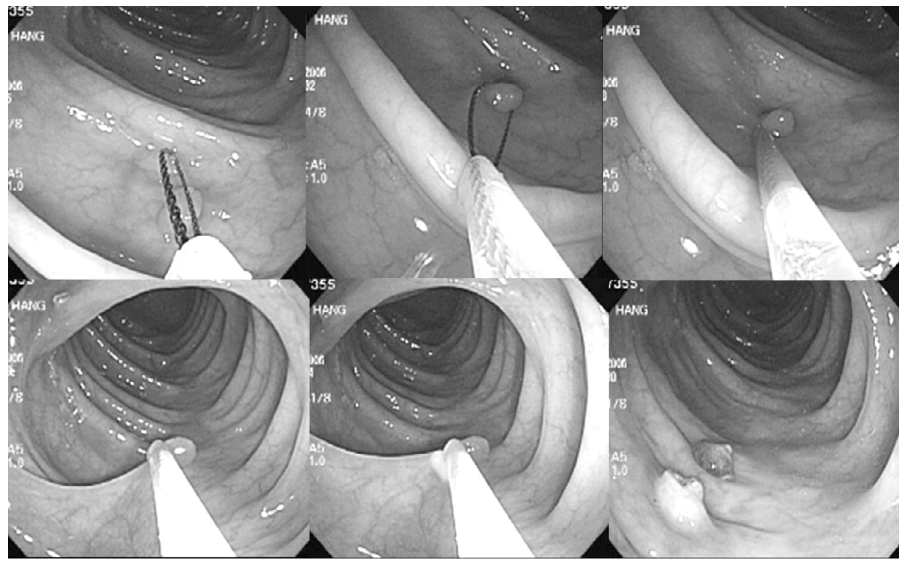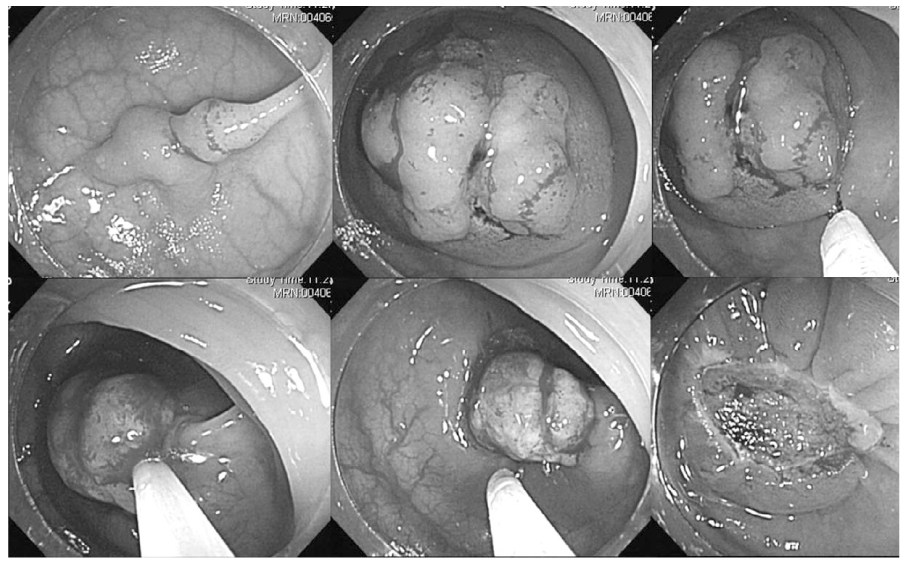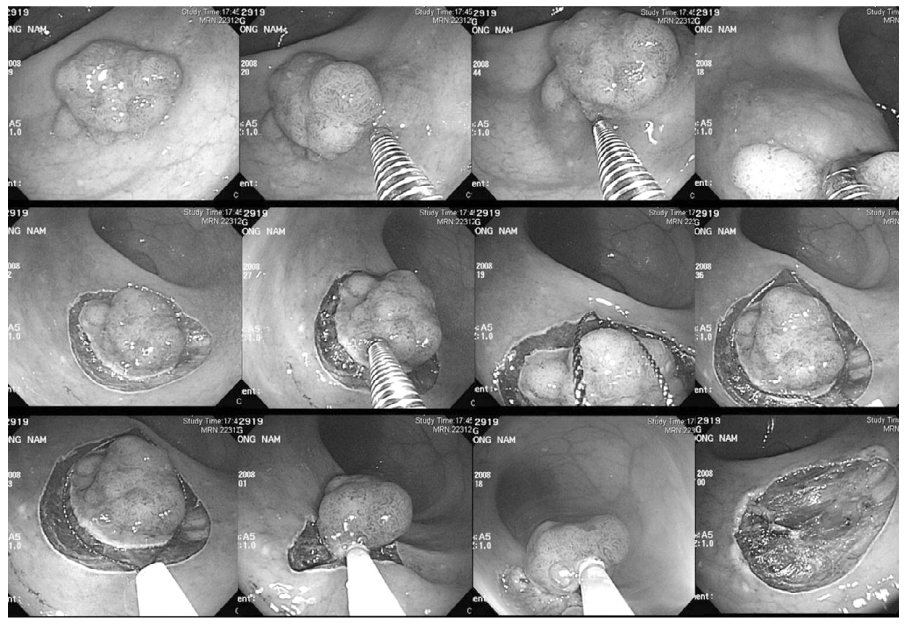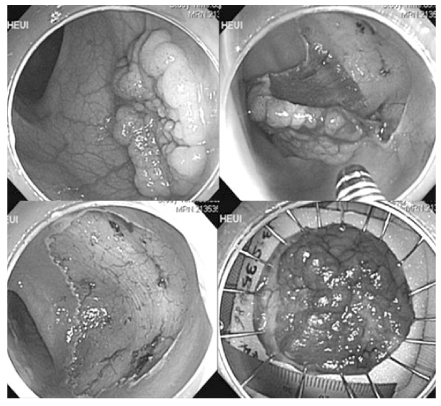J Korean Med Assoc.
2010 Jul;53(7):549-561. 10.5124/jkma.2010.53.7.549.
Endoscopic Diagnosis and Treatment of Colorectal Cancers
- Affiliations
-
- 1Department of Internal Medicine, Samsung Medical Center, Sungkyunkwan University School of Medicine, Seoul, Korea. dkchang@skku.edu
- KMID: 2188328
- DOI: http://doi.org/10.5124/jkma.2010.53.7.549
Abstract
- Colonoscopy is the best screening tool to detect colorectal cancer in early stage and also a potent arm to prevent development of cancer by removing colorectal adenoma. Superficial colorectal neoplastic lesions are primary targets of colonoscopic resection. Adenoma, carcinoma in situ, and cancer with minimal submucosal invasion are included in this category. One stage endoscopic treatment without the preceding biopsy confirmation is preferable, and thus endoscopic evaluation to identify the characteristics of the superficial neoplastic lesions is of importance. Gross endoscopic appearance and pit pattern and/or vascular pattern of the surface epithelium of the polypoid and nonpolypoid superficial lesions provide useful clue to predict histology of the lesions and depth of cancer invasion with reasonable accuracy. Appropriate treatment can be directed through this endoscopic evaluation step. Conventional snare polypectomy and endoscopic mucosal resection is mainstay of endoscopic treatment. Recently introduced endoscopic submucosal dissection facilitated en bloc resection of a large neoplastic lesion. After endoscopic resection, accurate pathologic evaluation is necessary to determine whether colonoscopic follow up or further surgical resection is needed. Poorly or undifferentiated cancers, cancers massively invading submucosal layer deeper than 1,000 micrometer, lymphovascular invasion of cancer cells, or presence of cancer cells on the resection margin are indications of further surgical resection because of the significant risk in metastasis to the regional lymph nodes. Colorectal polyps and early cancers are effectively treated by colonoscopy in most cases. Early detection by an adequate screening program is essential for this purpose.
Keyword
MeSH Terms
Figure
Reference
-
1. Levin B, Lieberman DA, McFarland B, Andrews KS, Brooks D, Bond J, Dash C, Giardiello FM, Glick S, Johnson D, Johnson CD, Levin TR, Pickhardt PJ, Rex DK, Smith RA, Thorson A, Winawer SJ. American Cancer Society Colorectal Cancer Advisory Group. US Multi-Society Task Force. American College of Radiology Colon Cancer Committee. Screening and surveillance for the early detection of colorectal cancer and adenomatous polyps, 2008: a joint guideline from the American Cancer Society, the US Multi-Society Task Force on Colorectal Cancer, and the American College of Radiology. Gastroenterology. 2008. 134:1570–1595.
Article2. Mandel JS, Bond JH, Church TR, Snover DC, Bradley GM, Schuman LM, Ederer F. Reducing mortality from colorectal cancer by screening for fecal occult blood. Minnesota Colon Cancer Control Study. N Engl J Med. 1993. 328:1365–1371.
Article3. Lieberman DA, Weiss DG. One-time screening for colorectal cancer with combined fecal occult-blood testing and examination of the distal colon. N Engl J Med. 2001. 345:555–560.
Article4. Imperiale TF, Wagner DR, Lin CY, Larkin GN, Rogge JD, Ranso-hoff DF. Risk of advanced proximal neoplasms in asymptomatic adults according to the distal colorectal findings. N Engl J Med. 2000. 343:169–174.
Article5. Schoen RE, Weissfeld JL, Pinsky PF, Riley T. Yield of advanced adenoma and cancer based on polyp size detected at screening flexible sigmoidoscopy. Gastroenterology. 2006. 131:168–1689.
Article6. Winawer SJ, Zauber AG, Ho MN, O'Brien MJ, Gottlieb LS, Sternberg SS, Waye JD, Schapiro M, Bond JH, Panish JF, Ackroyd F, Shike M, Kurtz RC, Hornsby-Lewis L, Gerdes H, Stewart ET. The National Polyp Study Workgroup. Prevention of colorectal cancer by colonoscopic polypectomy. The National Polyp Study Workgroup. N Engl J Med. 1993. 329:1977–1981.
Article7. Citarda F, Tomaselli G, Capocaccia R, Barcherini S, Crespi M. Italian Multicentre Study Group. Efficacy in standard clinical practice of colonoscopic polypectomy in reducing colorectal cancer incidence. Gut. 2001. 48:812–815.
Article8. Pabby A, Schoen RE, Weissfeld JL, Burt R, Kikendall JW, Lance P, Shike M, Lanza E, Schatzkin A. Analysis of colorectal cancer occurrence during surveillance colonoscopy in the dietary Polyp Prevention Trial. Gastrointest Endosc. 2005. 61:385–391.
Article9. Farrar WD, Sawhney MS, Nelson DB, Lederle FA, Bond JH. Colorectal cancers found after a complete colonoscopy. Clin Gastroenterol Hepatol. 2006. 4:1259–1264.
Article10. Bressler B, Paszat LF, Vinden C, Li C, He J, Rabeneck L. Colonoscopic miss rates for right-sided colon cancer: a population-based analysis. Gastroenterology. 2004. 127:452–456.
Article11. Kudo S, Lambert R, Allen JI, Fujii H, Fujii T, Kashida H, Matsuda T, Mori M, Saito H, Shimoda T, Tanaka S, Watanabe H, Sung JJ, Feld AD, Inadomi JM, O'Brien MJ, Lieberman DA, Ransohoff DF, Soetikno RM, Triadafilopoulos G, Zauber A, Teixeira CR, Rey JF, Jaramillo E, Rubio CA, Van Gossum A, Jung M, Vieth M, Jass JR, Hurlstone PD. Nonpolypoid neoplastic lesions of the colorectal mucosa. Gastrointest Endosc. 2008. 68:S3–S47.
Article12. Kevin AT, Douglas KR. Colonoscopic polypectomy. gastroenterology clinics of North America. 2008. 37:229–251.
Article13. Chang DK. Tips for optimal colorectal ESD. Korean J Gastrointest Endosc. 2008. 36:210–214.14. Chang DK. How to resect LST-endoscopist's viewpoint. Korean J Gastrointest Endosc. 2008. 37:88–93.15. Chang DK. Right colon ESD. Korean J Gastrointest Endosc. 2008. 39:165–168.16. Chang DK. Various methods of polypectomy. Intestinal research. 2008. 6:136–143.17. Van Gossum A, Cozzoli A, Adler M, Taton G, Cremer M. Colonoscopic snare polypectomy: analysis of 1485 resections comparing two types of current. Gastrointest Endosc. 1992. 38:472–475.
Article18. Di Giorgio P, De Luca L, Calcagno G, Rivellini G, Mandato M, De Luca B. Detachable snare versus epinephrine injection in the prevention of postpolypectomy bleeding: a randomized and controlled trial. Endoscopy. 2004. 36:860–863.
Article19. Shioji K, Suzuki Y, Kobayashi M, Nakamura A, Azumaya M, Ta-keuchi M, Baba Y, Honma T, Narisawa R. Prophylactic clip application does not decrease delayed bleeding after colono-scopic polypectomy. Gastrointest Endosc. 2003. 57:691–694.
Article20. Levin TR, Zhao W, Conell C, Seeff LC, Manninen DL, Shapiro JA, Schulman J. Complications of colonoscopy in an integrated health care delivery system. Ann Intern Med. 2006. 145:880–886.
Article21. Tanaka S. Basic technique of endoscopic mucosal resection and endoscopic submucosal dissection for colorectal tumors-knack, pitfall, and conclusive evidence of adjustment. 2006. Medical view co., Ltd.22. Tanaka S, Oka S, Chayama K. Colorectal endoscopic submucosal dissection: present status and future perspective, including its differentiation from endoscopic mucosal resection. J Gastroenterol. 2008. 43:641–651.
Article
- Full Text Links
- Actions
-
Cited
- CITED
-
- Close
- Share
- Similar articles
-
- Endoscopic diagnosis and treatment of early colorectal cancer
- Diagnosis and Treatment of Depressed Colorectal Neoplastic Lesion
- Endoscopic Diagnosis and Treatment of Early Colorectal Cancer
- Colorectal Cancer after Colonoscopy: Causes and Prevention Strategies
- Characteristics and outcomes of endoscopically resected colorectal cancers that arose from sessile serrated adenomas and traditional serrated adenomas






